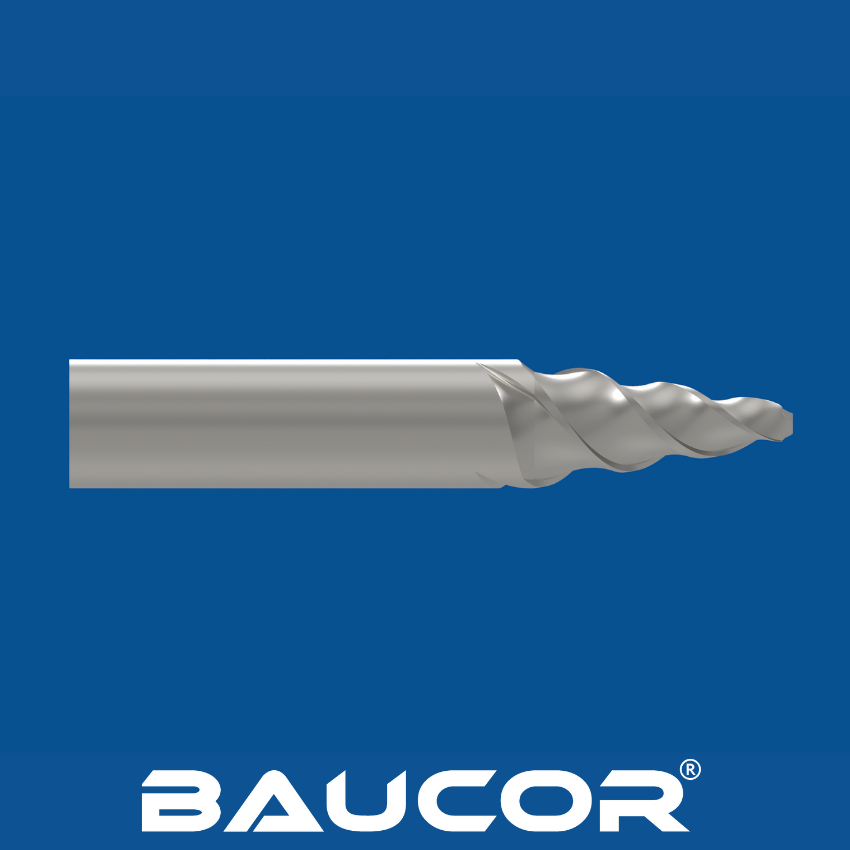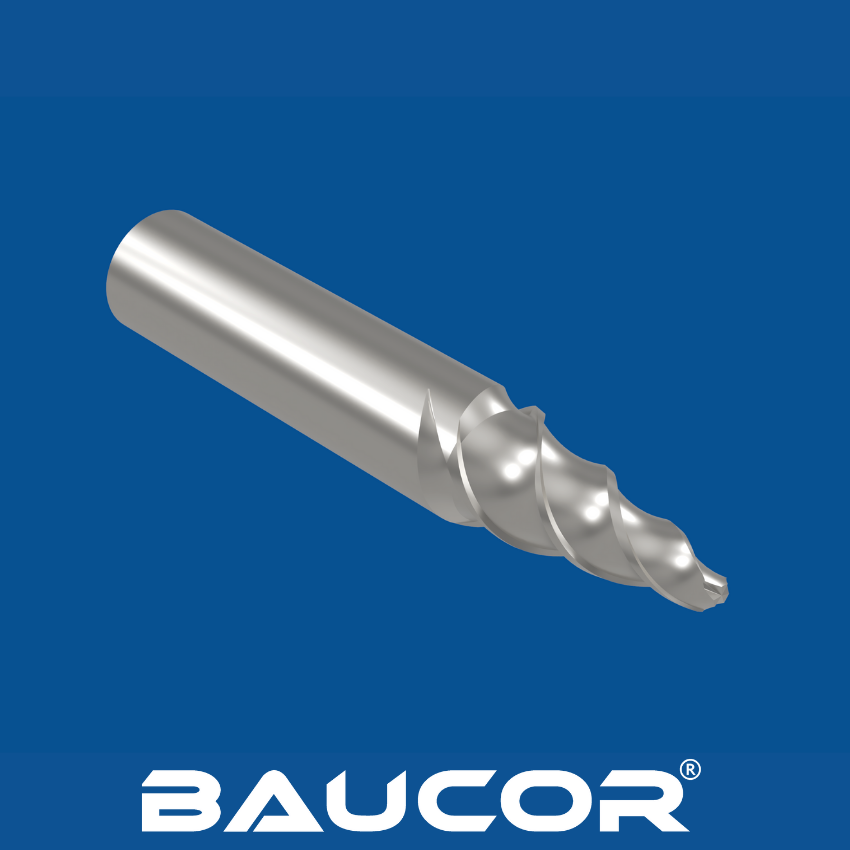EFFICIENCY AND PRECISION WITH BAUCOR END MILLS
YOUR ULTIMATE CUTTING TOOL!
EFFICIENCY AND PRECISION WITH BAUCOR END MILLS
YOUR ULTIMATE CUTTING TOOL!
What are Die Sinking Cutters?
Die sinking cutters, also known as die sinker end mills, are specialized cutting tools designed for precise 3D contouring and cavity creation in CNC machining. They are essential for producing molds, dies, and intricate parts with complex shapes and details. Baucor, a leader in precision tooling, offers a wide range of die sinking cutters engineered for optimal performance and longevity.
How Do Die Sinking Cutters Work?
Die sinking cutters typically have a cylindrical or tapered shape with multiple cutting edges (flutes) that spiral around the tool. They are mounted in the spindle of a CNC machine and rotate at high speeds. The CNC machine precisely controls the movement of the cutter along multiple axes, allowing it to follow a programmed path and gradually remove material from the workpiece.

The manufacturing of die sinking cutters, particularly those of high quality like Baucor's, involves a series of intricate steps that demand precision and expertise:

At Baucor, we pride ourselves on offering a comprehensive range of die sinking cutters to cater to the diverse needs of CNC machining professionals. Our commitment to precision and versatility means we can provide die sinking cutters in virtually any size you require.
Here's a glimpse of the extensive range of sizes we offer:

Back corner rounding end mill is a specialized cutting tool designed to create precise radii (rounded corners) on the backside of a workpiece (the side facing away from the machine spindle).

Porting tools are specialized cutting and grinding tools used to modify the intake and exhaust ports within an engine's cylinder head.

A Tapered End Mill is a cutting tool with a conical shape, where the diameter gradually decreases from the shank to the tip, used for machining angled surfaces, deep cavities, and tapered features in various materials.

Engraving Cutter with a Radius is a precision cutting tool designed for engraving and detailing, featuring a tip with a rounded radius to create smooth, curved cuts and intricate designs on various materials.
Die sinking cutters are typically made from two primary materials, each with its own advantages and ideal applications:
Solid Carbide:
Benefits:
High-Speed Steel (HSS):
Additional Considerations:

Lollipop cutters, also known as undercut end mills or ball nose end mills with necks, are specialized cutting tools used for a variety of machining tasks.


A Double-End Corner Rounding End Mill is a cutting tool with rounded cutting edges on both ends, used to create rounded corners or radii on the edges of a workpiece, enhancing efficiency by allowing use of both ends.

A Clearance Cutter - Ball End Mill is a type of end mill with a rounded tip (ball end) and a reduced diameter or relieved shank, designed to provide clearance for machining intricate surfaces, deep cavities, and complex shapes while minimizing tool interference.
Applying coatings to die sinking cutters significantly enhances their performance, durability, and overall effectiveness in CNC machining. These coatings, often just a few microns thick, create a protective layer on the cutter's surface, improving its properties and extending its lifespan. Here are some of the most common coatings that improve die sinking cutters:
Choosing the Right Coating:
The optimal coating for your die sinking cutter depends on various factors, including the workpiece material, cutting conditions, desired tool life, and budget. It is crucial to consult with a knowledgeable supplier like Baucor to determine the most suitable coating for your specific application.
Baucor's Expertise:
At Baucor, we offer a wide range of die sinking cutters with various coatings to meet your specific needs. Our team of experts can guide you through the selection process, ensuring that you choose the right coating for optimal performance, tool life, and cost-effectiveness in your CNC machining operations.
Die sinking cutters are essential tools in various industries that require precise 3D contouring and cavity creation in CNC machining. Their ability to plunge, side mill, and contour makes them invaluable for producing complex shapes and intricate details. Here are some of the key industries where die sinking cutters are extensively used:
Mold Making:
Die Making:
Aerospace Industry:
Medical Industry:
Other Industries:
Overall, die sinking cutters are indispensable tools in modern manufacturing, enabling the creation of intricate shapes and details in a wide range of industries. Their precision and versatility make them a valuable asset for any CNC machining operation that requires the production of complex, high-quality parts.
Die sinking cutters are versatile tools employed in a wide range of industries that require precise 3D contouring and cavity creation in CNC machining. Here are some of the key industries where die sinking cutters are extensively used:
Mold and Die Making:
Aerospace Industry:
Medical Device Manufacturing:
Automotive Industry:
Other Industries:
In conclusion, die sinking cutters are versatile tools that play a crucial role in a wide range of industries where precision machining is essential. Their ability to create intricate shapes and contours makes them indispensable for producing high-quality molds, dies, and complex components across various sectors.
Die sinking cutters are primarily used with CNC (Computer Numerical Control) machines, which offer the precision and control required for intricate 3D contouring and cavity creation. Here's a breakdown of the specific CNC machines that utilize die sinking cutters:
Vertical Machining Centers (VMCs):
Horizontal Machining Centers (HMCs):
High-Speed Machining Centers (HSMCs):
5-Axis Machining Centers:
Additional Considerations:

End Mill Neck Relief is the reduced diameter section behind the cutting edge of an end mill, designed to provide clearance and reduce tool deflection during deep cutting operations.

Corner Radius End Mills have a rounded cutting edge, ideal for creating smooth, curved surfaces and fillets.

Tapered Ball Nose End Mill is a specialized cutting tool with a tapered body and rounded tip, ideal for 3D contouring and smooth surface finishing in CNC milling and engraving applications.

Pointed chamfer cutters are a type of end mill used specifically for creating chamfers – angled cuts that transition between two surfaces.
At Baucor, we go beyond providing high-quality die sinking cutters; we are your trusted partner in achieving precision CNC machining. We offer comprehensive design and engineering support throughout your project, ensuring optimal performance and results.
Here's how Baucor supports you:
Expert Consultation and Tool Selection:
Custom Cutter Design and Manufacturing:
Technical Support and Training:
Continuous Improvement and Innovation:
Partnering with Baucor:
By partnering with Baucor, you gain access to:
We are dedicated to helping you achieve your precision machining goals. Contact us today to learn more about our die sinking cutters and how our design and engineering support can elevate your CNC machining capabilities.

BAUCOR offers custom manufacturing and engineering solutions tailored to your specific needs, across various industries.

BAUCOR's engineers can review your design and provide feedback to improve manufacturability, cost effectiveness, and efficiency.


ADesigning effective die sinking cutters requires careful consideration of various factors to ensure optimal performance, precision, and tool life in CNC machining applications. Here are the key design guides for die sinking cutters:
Cutter Geometry:
Material Selection:
Coatings:
Application-Specific Considerations: